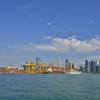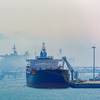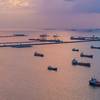HydroComp PropElements 2017- Update
HydroComp PropElements 2017 – the propeller “design for performance” code from HydroComp,Inc. of Durham NH USA – is the latest build of the company’s commercial software for marine propeller design and analysis. Propeller specialists will find it an essential addition to their software tools, and also tackles the component-level hydrodynamic needs of naval architects.
Why PropElements?
Still an uncharted domain for many naval architects, propeller design is an iterative process following a typical design spiral – from initial sizing through detail design. System-level propulsion design and analysis tools (such as HydroComp NavCad) are used in early design stages to identify principal propeller parameters (e.g., diameter, pitch, blade area, number of blades) and to even make a first assessment on certain performance details, such as hydroacoustics. It is after this point that naval architects typically defer final propeller details to the manufacturer or a specialized consultant.
With the advent of custom and semi-custom propellers – common place for new vessel designs – naval architects now have a new set of technical challenges. These propellers differ from stock “series” or “off-the-shelf” propellers in two principal ways.They are:
• designed using contemporary foil geometries, and
• optimized and fitted to the individual vessel (or vessel type).
To fully take advantage of the benefits that custom or semi-custom propellers make available – or to evaluate them in service – naval architects must look to a different kind of propeller calculation.
Of course, specialists can use PropElements to help prepare the final design for a particular application, but now with PropElements 2017 – the latest version of HydroComp’s tool for wakeadapted propeller design – naval architects can become a meaningful participant in the design and analysis of these contemporary propellers at later design stages. For example, they can employ PropElements to conduct studies of alternatives prior to development of the final design, as well as to confirm and check these designs.
How PropElements 2017 works
In wake-adapted propeller design, a custom propeller is optimally matched to the unique inflow properties of the vessel, or its “wake field”. (See Figure 1 below for an example of radial averaged velocities derived from the wake field.) PropElements is able to consider axial and tangential inflow properties, and ascertain optimized distributions of pitch and camber for prescribed foil characteristics. Of course, the propeller design process with PropElements takes into account blade strength, tip and hub loading, and cavitation. Its calculation pages include Propeller, Performance, and Strength; with supplemental calculations such as for the creation of KT-KQ curves. (See Figure 2 for a sample screen shot.)
The foundation of PropElements is a unique distributed blade foil code, with empirical connections that allow analyses to be viscous and fully-scalable. (These corrections are made possible through HydroComp's experience in hybrid empirical-numerical hydrodynamics.) PropElements also supports standard nozzle styles (such as 19A, 33 and 37), with optional support for contemporary high-efficiency nozzles and tunnel thrusters.
Detailed analysis of propeller performance
PropElements can also be applied to analysis, as well as design. The ability to investigate radial values of foil lift and cavitation number, for example, can help identify potential sources of root cavitation or blade impulse excitation. It can help evaluate tip loading (for hydroacoustics), and also be employed in forensic investigations of blade failure.
Export of KT-KQ curves can be applied to system level calculations in replacement of direct propeller series predictions. For example, KT-KQ curves from PropElements 2017 can be
exported in a form that can be used with HydroComp NavCad for propulsion analysis. (Figure 3 shows the results of a calculation study with PropElements 2017.)
Interaction with HydroComp design tools, CFD, and FEA
A number of Import and Export options make PropElements an important companion for HydroComp's NavCad and PropCad software, as well as the perfect pre-processor for higherorder flow codes, CFD, and FEA. For example, early-stage performance prediction is typically conducted using NavCad. One unique NavCad feature is “Aligned Series” propeller performance, where KT-KQ data from model tests – or from PropElements – can be used to correlate custom propeller performance to series calculations. Then, when the propeller has gone through the “design for performance” process with PropElements, its “design for manufacture” can be completed in PropCad. CFD and FEA calculation benefit from PropElement’s calculation of proper body forces.
Validation of PropElements
HydroComp conducts formal benchmark validation studies for PropElements using model test data for quantitative fidelity, and CFD studies to confirm scalability and qualitative outcomes. Two examples of these studies for PropElements 2017 are shown below.
“Pump flow” calculations
The useful domain for PropElements 2017 is not limited to marine propellers. It has also been extensively used for propeller-like pump and industrial mixer design and analysis. Novel proprietary features support accurate prediction of static high-thrust loading and corresponding “induced volumetric flow rate” for these devices.
Summary
Engine power densities will grow; fuel costs will increase; and emission reduction will become more urgent – all leading to the greater use of specialized propeller designs. With more propeller builders now capable of delivering “made to order” propellers, custom and semi-custom propellers of wake-adapted design should be considered for new construction and repowers.
The widespread installation of these propellers also suggests that naval architects need the ability to analyze their performance in greater detail than has typically been available. Whether for confirmation of propeller designs for new-build projects or the post-delivery evaluation of trial performance, HydroComp PropElements 2017 should become a commonplace fixture in a naval architect’s toolbox.











